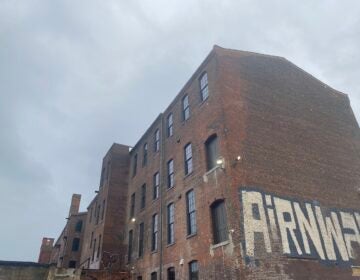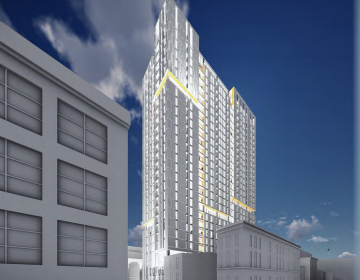Philly design board, neighbors decry plan for Callowhill storage facility
“I can’t say anything positive about this project,” said Daniel Garofalo, environmental sustainability director at the University of Pennsylvania and CDR member.

A rendering of a storage facility planned for 1314 Spring Garden Street. (JKRP Architects/ Johnson Development Associates Inc.)
This article originally appeared on PlanPhilly.
—
Philadelphia’s Civic Design Review board has added its voice to a loud chorus of opposition to a plan to build a six-story storage facility in the middle of the growing Callowhill neighborhood.
The city’s design board is meant to be a forum for offering design feedback to developers, but board members agreed at a Tuesday meeting that the project is so offensive to the public realm that the proposed use is a valid topic of discussion.
“I can’t say anything positive about this project,” said Daniel Garofalo, environmental sustainability director at the University of Pennsylvania and CDR member. “Bringing it before a design review committee … it’s a like a Monty Python routine. It’s just a joke. There is no way we should have a storage facility in this neighborhood.”
Located at 1314 Spring Garden Street and now used as a parking lot, the property in question is zoned CMX-4, one of the zoning districts that allows very dense and tall development. The developers for the project, Johnson Development Associates and Metro Development Company, have claimed that the variance to allow a storage facility in the neighborhood is necessary because residential isn’t possible due to a nearby drug rehabilitation site.
Johnson is developing the storage portion of the project, while Metro’s owner Michael Grasso, who purchased the site in 1994 for $350,000, is developing five retail spaces on the building’s ground floor.
But new condo and apartment high rises have been going up at an impressive rate in the area in recent years, transforming it from a relatively sparsely populated neighborhood dominated by light industry — and inspiration for David Lynch’s Eraserhead — to a rapidly developing high-rise community.
Philadelphia’s new High Line-inspired rail park is three blocks away from the site, and the Broad Street Subway’s Spring Garden station is just a short walk away.
The current average rent for a two-bedroom apartment in the area is $2,229 a month, compared to a citywide average of $1,523, according to Rentcafe.
The Planning Commission, neighborhood groups, and City Councilman Mark Squilla have all protested against the idea of placing a 123,000-square-foot storage unit in this neighborhood just to the north of Center City.
The Philadelphia Inquirer’s architecture critic, Inga Saffron, wrote a fierce dissent against the storage facility as well saying that such uses “generate no foot traffic, they create a dead zone in the middle of urban neighborhoods.”
The plan includes more than 10,000 square-feet of retail on the ground floor, but the idea of a dedicating the stories above to storage came as an offense to the board. Garofalo concluded his comments by asking why they couldn’t just keep the retail and replace the six floors of storage units with artist lofts?
All of the design committee’s members felt much the same way.
“It defies imagination to say this is the only viable use for something in this location,” said Nancy Rogo Trainer, chair of the CDR committee and associate vice president of Planning and Design at Drexel University.
The Callowhill Neighbors Association’s president, John Struble, protested that there are still industrial areas to the north where a storage facility might make more sense. But at this location, within a short walk of City Hall and on a major subway line, this “mausoleum” is entirely inappropriate, he said
“This is a dead kind of use and not what we want in our neighborhood,” said Struble.
Despite the political pressure against the development, the city’s extremely permissive Zoning Board of Adjustment voted to grant the developer a variance to move forward with the project.
The Kenney administration is, however, appealing the decision of the mayor-appointed Zoning Board of Adjustment, so the criticisms the storage facility faced at CDR won’t be the final word on the project.
As a result of that pending litigation, the Planning Commission’s staffers refrained from comment on whether the project made sense and stuck to critiquing its shortage of windows, the soaring, undifferentiated wall it would create facing Broad Street, and the new curb cut it would add to Spring Garden Street.
The developers’ representatives also did not comment on the larger controversy, instead limiting themselves to explaining the project and how the storage component would operate.
“We’ll have access hours seven days a week, but not 24 hours because nothing good happens in the middle of the night,” said Bailey C. Gaffney, development manager of Johnson Development Associates’ self-storage division. “We lease up over the course of four years, one unit per day, if that.”
Gaffney said there would be about 1,000 storage units. There will be two employees, one at the front desk and one wandering around the building. The office hours would be five days a week, nine-to-five, while access hours would be seven days a week and available until 10 p.m. on weekdays with reduced hours on weekends.
In the end, the Civic Design Review Board voted unanimously to require the developer to come back for a second review.
But a second committee meeting on the project at 1314 Spring Garden Street is all that the CDR members can ask of the project’s developers. The board is purely advisory and there are no consequences for disregarding its feedback.
In its current form, however, it is difficult to imagine that a second round of criticism will differ substantially from the critiques heard Tuesday.
“This is a burgeoning area of the city, with massive changes occurring up and down North Broad Street,” said Cecil Baker, one of the most prominent architects in Philadelphia. “I have a very hard time buying into this.”
WHYY is your source for fact-based, in-depth journalism and information. As a nonprofit organization, we rely on financial support from readers like you. Please give today.







